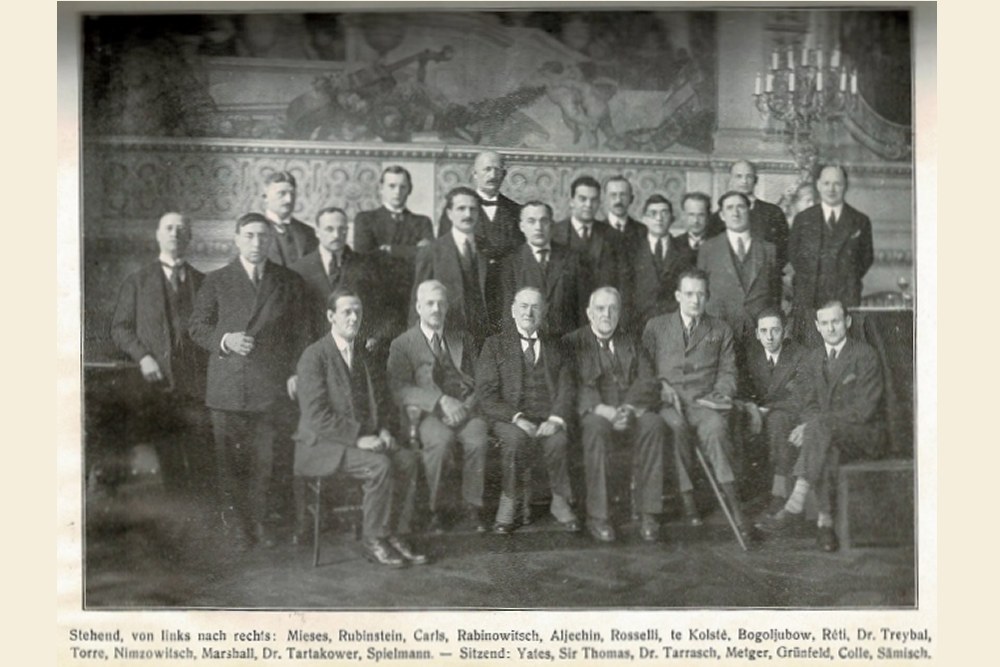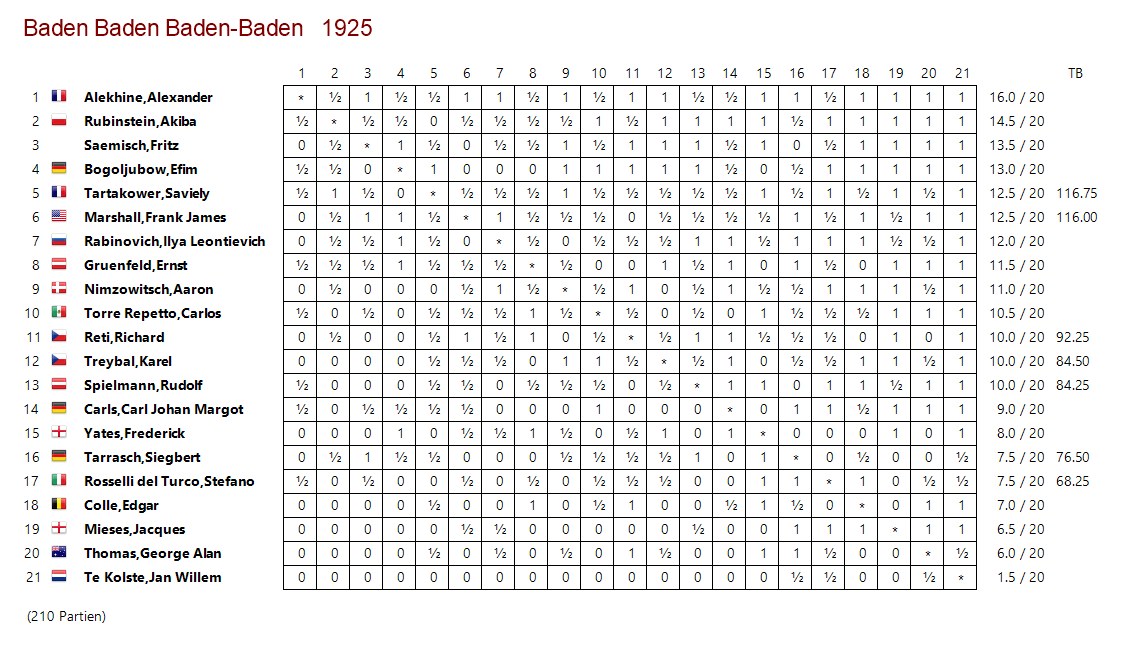


A hundred years ago, the legendary Baden-Baden 1925 tournament reflected the "glorious era of Hypermodern Chess"
"If there is one event that truly captures the flair and excitement of the glorious era of Hypermodern Chess, it must be the 1925 Baden-Baden tournament", states author Jimmy Adams. A century ago, nearly all the top players of the time came together, except for former world champion Emanuel Lasker, his successor José Raúl Capablanca, and the future champion Max Euwe. As with the first legendary tournament in 1870 – won by Adolf Anderssen – Baden-Baden 1925 once again made chess history. In celebration of its 100th anniversary on 16 April 2025, this brilliant event and its impressive games will be honoured.
It wasn't just the victory of tournament winner Alexander Alekhine over Richard Reti that stood out – Alekhine later described it in his game collection from 1924 to 1937 as the finest of his career. He was so pleased with the game that he lamented the lack of a beauty prize as the tournament's only shortcoming. Indeed, the tactical genius called for such a prize to be awarded at every tournament!
The archive material for the event, held from 16 April to 14 May, is extensive. Chessbase's database contains all 210 games, and several books have been written about the event.
Nimzowitsch opens with a brilliant game
The most beautiful work is arguably the one published in 1991 by Caissa Editions (USA), which compiled numerous sources. Author Jimmy Adams added analyses from the masters of the time. These appeared in 1927 in an outstanding book in the Soviet Union, enriched with annotations by local masters.
Dr Siegbert Tarrasch aimed, through the legendary 1925 tournament, to remedy the "unfortunate situation" that no major chess event had taken place in Germany since Mannheim 1914. Thus, the doctor from Nuremberg and grandmaster approached the municipal administration of the famous spa town of Baden-Baden in autumn 1924, known for its generous support of sports. Spa director Duschl supported the idea and chose the mid-range budget of 10,000 marks from the estimates of 16,500, 10,000, and 7,000.
The "Praeceptor Germaniae" (teacher of Germany) Tarrasch also published a volume containing all the games just one month after the tournament ended. "To not publish the games of such an important and strong tournament would be a suppression. However, I refrained from annotating them, as a thorough commentary would have taken too much time, and a superficial one – better none at all!", he wrote in his foreword three days after the event concluded. In the very first round, one of the leading figures of the Hypermodern School, Aaron Nimzowitsch, played a brilliant game which showed stunning conclusion.
Not only in the legendary 1925 Baden-Baden tournament were Savielly Tartakower and Jacques Mieses among the most colourful figures – they are also icons in chess history. Mieses gained fame not so much for his victories – his greatest was arguably Vienna 1907 – but more for the beauty prizes his uncompromising style earned him. In the spa town, he drew only three of his 20 games!
His opponent in round seven, Tartakower, managed to draw thirteen times. The fifth-placed finisher (12½ points) defeated the third-from-last (6½) in just 15 moves.
Yet Mieses was still very active – even at 80 years old, he earned a beauty prize in the seaside town of Hastings in 1945. At 62, he played for the German national team, and at 78, he toured England giving simultaneous exhibitions. A famous anecdote has him being greeted with: "Oh, Mister Mieses", to which he retorted: "No, Meister Mieses!"
Tartakower always quick-witted – even off the board
Tartakower was even quicker – both on and off the board. His aphorisms are legendary: "The mistakes are there, waiting to be made", "the penultimate mistake wins!" or "it's better to sacrifice your opponent's pieces!". The name he gave for the opening with 1.b4 also caught on after a zoo visit reminded him of an orangutan – hence the Orangutan Opening.
The Pole was a correspondent for 30 magazines, all of which loved publishing his "Tartakowerisms". His groundbreaking book The Hypermodern Game of Chess appeared the same year as the Baden-Baden tournament and honoured the new ideas of Richard Reti and Gyula Breyer. Tartakower's dual personality – a calm doctor of law and a gambling daredevil in the casino – earned him the nickname "Homer of Chess" by world champion Emanuel Lasker. He was both a peaceable player and a fearless fighter in the French Resistance during WWII.
"In the Middle Ages, wizard Rubinstein would have been burned"
After four rounds, Alexander Alekhine and Akiba Rubinstein were in the lead with 3½ points. "Rubinstein is in top form," noted Tarrasch as chronicler and organiser of the tournament a hundred years ago.
At the century's start, the Rubinstein was among the strongest players. His games were marked by "the colossal length of his plans, which served as a logical bridge from the opening to the endgame", as Nimzowitsch said admiringly. Tartakower joked about Rubinstein's virtuosity in rook endgames: "You're lucky to be living in the 20th century – in the Middle Ages, you'd have been burned for witchcraft. What you get out of rook endings is simply a miracle". The co-leader's tactical skill also showed in round four – against none other than the renowned tactician Rudolf Spielmann.
After a draw in the opening round against 19-year-old Mexican prodigy Carlos Torre, Alekhine launched into a brilliant streak – winning his next nine games! Even Rubinstein couldn’t keep up, as he trailed by 1½ points at the halfway mark. Correspondent Tartakower called his rival "chess nitroglycerin."
Alekhine had already played what he then considered his best game against Reti in the 1924 New York tournament. But this time, he surpassed even that. "I consider this game and the one against Bogoljubow in Hastings 1922 the finest of my chess career", confessed the champion who took the world title in 1927.
Nimzowitsch was highly dissatisfied with the outcome of the tournament. He finished ninth among 21 players with 11 points. Carl Carls, on the other hand, was less troubled by his slightly negative score of 9/20. The bank director from Bremen was an amateur – unlike his competitors – yet still achieved fame. Throughout his life, he always opened with 1.c4 when playing White. The opening was thus long referred to as the Bremen Game rather than the English Opening.
Once, jokers glued the pawn to c2 before a game just to see what would happen…
Tarrasch praises the "brilliantly run tournament"
For Baden-Baden 1925 initiator Siegbert Tarrasch, the tournament didn't go well personally. Revered as the "teacher of Germany", the 63-year-old was well past his prime, having once been considered a worthy challenger to world champion Emanuel Lasker. He finished only 16th out of 21 with 7½ points.
Still, the once combative Tarrasch – who was fond of flowery excuses – offered a very positive summary: "After more than four weeks, the brilliantly run tournament has come to a close in every respect".
Winner Alekhine a "formidable rival" for world champion Capablanca
The Nuremberger especially praised the winner: "This brilliant competition was matched by the brilliant success of the victor. The Russian grandmaster Alexander Alekhine didn't lose a single game, won 12 and drew 8 – showing remarkable consistency, especially since he never once ended up in a significantly worse position", said Tarrasch, not only lauding Alekhine but also comparing him to José Raoul Capablanca. "In any case, a formidable rival has emerged for the world champion – one who grows stronger with each year", he seemed to predict Alekhine's 1927 dethroning of Capablanca.
Tarrasch's hopes fulfilled only later
In the tournament book, Tarrasch concluded: "The tournament has attracted great interest everywhere", noting global coverage. "Given the positive outcome of the inspiring event, a repeat is planned for the next year – perhaps even annually". However, this noble goal was not realised in 1926 for unknown reasons.
It wasn't until 1980 that Baden-Baden returned to the chess world's spotlight – except for a brief moment in 1934, when Alekhine began his World Championship match against Jefim Bogoljubow (just behind Fritz Sämisch in fourth place with 13 points) in the spa town. Later, in the 1990s, Joachim Heiermann brought chess back to life in Baden-Baden – especially with world champion Garry Kasparov's clock simultaneous exhibition against the German national team. Kasparov's 3-1 win earned him a luxury BMW worth 70,000 marks.
Wolfgang Grenke continues the great legacy
Most notably, Wolfgang Grenke has revived the rich chess tradition of his hometown. Inspired by the historic 1870 and 1925 tournaments, he brought top-level chess to Baden-Baden: his own club, the Ooser Schachgesellschaft (OSG) Baden-Baden, became a record-holding champion in the Bundesliga. Over Easter, the successful leasing entrepreneur also established a grandmaster tournament – attracting elite players like Magnus Carlsen, who added his name to the list of Baden-Baden champions.
The popularity of the accompanying events eventually exceeded the capacity of the spa town with its 56,000 residents. Thus, the major chess spectacle moved to nearby Karlsruhe, where over Easter Carlsen and more than 3,000 chess enthusiasts now compete across 64 squares.
To conclude, here is a fine win by Ernst Grünfeld in round 18. The namesake of the Grünfeld Defence defeated Tarrasch with a spectacular queen sacrifice.
Crosstable

The great classical chess tournament with many contemporary commentaries are available in the Mega Database.
All Games
| Advertising |